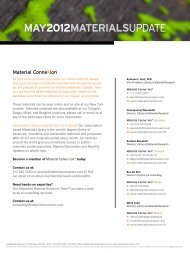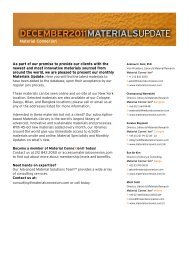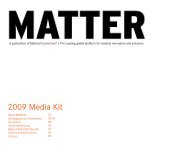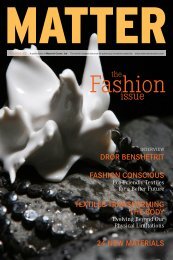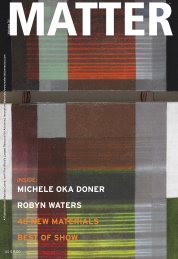48 new materials - Material ConneXion
48 new materials - Material ConneXion
48 new materials - Material ConneXion
You also want an ePaper? Increase the reach of your titles
YUMPU automatically turns print PDFs into web optimized ePapers that Google loves.
Photo: Untitled, 2003 by Frank Breuer; Courtesy of Fiedler Contemporary<br />
truck. With that task removed, shipping prices fell<br />
dramatically. Such retailers as Wal-Mart and Ikea<br />
are inconceivable without containerized shipping.<br />
Toyota tracks engines from Japanese factories by<br />
GPS and RFD so they arrive at Canadian assembly<br />
lines to be installed almost down to the minute.<br />
Critical as the boxes are to our economy, we see<br />
them only rarely, at the edge of the water, the<br />
airport, or the highway. When they make appearances<br />
in movies and on TV, they tend to be associated<br />
with the seamier side of trade. The boxes’<br />
very ubiquity and hard-shelled uniformity make<br />
them the perfect cover.<br />
Only recently, for political and security reasons,<br />
we have begun to notice the boxes. We worry<br />
about who controls the ports and piers that load<br />
and unload them.<br />
But artists, photographers, and architects have<br />
been noticing them for a while. Photographer<br />
Edward Burtynsky sees the stacking and sorting<br />
of boxes on the docks as an “unintentional architecture.”<br />
In his images, shipping containers, piled<br />
four or six high, combine a playful, kid’s-block<br />
quality with the wear and grit of the real world.<br />
They are symbols of the global economy, Legos<br />
of the New Order.<br />
Burtynsky says, “I began to see containers as conduits<br />
for globalization. These are the things that<br />
make it happen. … We all partake of [the global<br />
economy] but rarely see it. We are normally disconnected<br />
from it.”<br />
A different approach to containers is that of<br />
German photographer Frank Breuer, who studied<br />
with Berndt and Hilla Becher.<br />
Breuer, who taught at Harvard last year and has<br />
shown his work at the Rocket Gallery in London,<br />
the Feigen Gallery in New York and the Fiedler<br />
Gallery in Cologne, spends a lot of time around<br />
ports looking for arrangements that please him.<br />
He is fascinated by the abstraction of the colors<br />
and modular, scale-less quality of the boxes. He<br />
looks for just the right stacks; Antwerp, he told<br />
me, was an especially good port for his purposes.<br />
Burtynsky, too, is drawn to the ports. His photos of<br />
them “are meant as metaphors to the dilemma of<br />
our modern existence; they search for a dialogue<br />
Photo: © LOT-EK<br />
between attraction and repulsion, seduction and<br />
fear. We are drawn by desire—a chance at good<br />
living, yet we are consciously or unconsciously<br />
aware that the world is suffering for our success.”<br />
The boxes represent trends in trade. In the U.S.<br />
and Europe says Burtynsky, “Because of the trade<br />
imbalance, there is a huge oversupply of empty<br />
containers, so people try to figure out how to reuse<br />
them. It costs too much to send them back<br />
empty.”<br />
3x3 CHK (Container Home Kit) by LOT-EK<br />
For this reason, they have been salvaged for storage<br />
spaces. Construction crews these days often<br />
turn shipping boxes into their own crude architecture<br />
for on-site offices and storage.<br />
Over the last few years, architects have begun<br />
highly publicized experiments with recycling the<br />
containers in building. They have been used for<br />
dwellings by the firm LOT/EK. Shigeru Ban, known<br />
for paper and cardboard buildings, assembled<br />
them into a huge temporary museum on the<br />
Manhattan waterfront. In London, artists now<br />
live and work in two dwelling complexes called<br />
Container Cities—a good symbol of the extent to<br />
which our lives have become inseparable from<br />
these anonymous boxes.<br />
IN THE MATERIAL WORLD<br />
31




